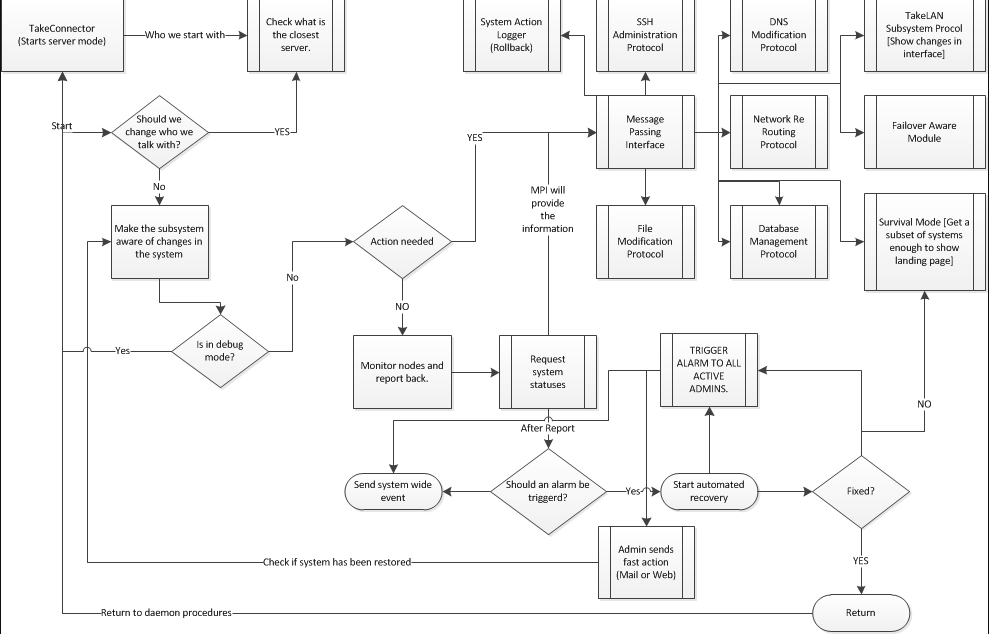August 02, 2013
Server Monitor little dirty script.
Jarvis – DLA (Digital Life Assistant)
The idea behind MultiAll
Abstract:
The problem of managing multiple servers that do basically similar stuff and are used to host in house applications. Avoiding configuration time hogs, and automation of server configuration allowing fast deployments with no scaling limit.
The problem:
The problem with MultiAll is the fact of having all the servers on sync when they are in different “Farms or Grids” and the fact that one server can provide services to more than one porpuse. This is why we invent the “Pool system” where all the servers respond or act for a defined pool.
If a server responds to multiple pools the aggregation of every pool is the server.
Understanding how we can make it work:
Under our research its possible to merge more than one server to work for a common goal, doing some modifications to the normal database driven apps to have a cache table, and when that server is unable to communicate to others under the same pool they save the changes they have to make to their brother servers and later on when they are back online deploy the changes.
On the file system side, every server is responsible of keeping others from the same pool up to date, bi partitioning the problem as every server is responsible for others and their self. We’re doing similar to how Rsync works, and we would only push differences between servers under a secure connection IE: (VPN).
By this moment we would have a DB Layer abstraction for multiple servers responding to a DB and file system.
Next is the Domain Name Server problem, that we don’t want clients reaching servers that are offline due to maintenance or problems, for this we’re developing on BIND 9 an abstraction layer that every server in a pool must be “Network Aware” of others of his kind, and if hes unable to reach others, then he must change the DNS registry to reflect the changes.
How MultiAll solves the problem:
Basically MultiAll will work as a service provider inside the server, as a global abstraction layer, and once the application is provided with a bridge or connection layer to it, it would be able to take advantage of the system. MultiAll has as key features:
- Topology-Aware Neighboring System (TNS): provides a topology discovery service for the servers (or “nodes”), which may eventually “recalculate” the topology in case of unexpected downtime (such as network, power or hardware failures, among others) or in cases of planned downtime (such as server maintenance, hardware upgrades or migrations). The different synchronization agents of the “Multi All” depends on information learned through TNS, therefore it is considered a critical component of the “Multi All” system.
- System Baseline Monitor (SBM, formerly known as “checker”): provides a 24/7 server health monitoring, locally on each server (or “node”) using “Baseline Rules”. These rules are defined on a “per pool” or “per server” basis, allowing the configuration to be as granular as needed, making exceptions if the need arises. The health status is published via TNS using standardized codes known as “SBM Statuses”. It is also considered a critical component of the “Multi All” system.
- File System Synchronization Agent (FS-SA): lets you define structures inside your filesystem to keep synchronized across a pool of servers. FS-SA, used in combination with the rest of the “Multi All’s” Synchronization Agents (SA’s) provides you with high availability, data redundancy and server load balancing on your pool of servers.
- Software and Libraries Synchronization Agent (SL-SA): especially useful for large-scale unattended deployments, the SL-SA keeps all your software packages, services and libraries consistent across the pool, raising awareness to the system administrators when possible conflicts, incompatibilities or other issues arise.
- Database Synchronization Agent (DB-SA): keeps the different database servers of the pool synchronized. Depending on the needs of the underlying applications, the DB-SA may either work 24/7 to keep the DBs in perfect sync, or you could define your own database synchronization policies.
- Domain Name System Synchronization Agent (DNS-SA): keeps the DNS zones up to date with the pool’s topology either via a pull-push synchronization mechanism (handled by the FS-SA) or by rebuilding the DNS zone according to the topology discovered by the TNS.
The project has gotten a bit more ambitious… so here is how its changed!
Okay so some research has been going on, and the project has been growing quite a bit. Among the changes that have been happening around, it has gotten bigger, now all the things stated before, are part of a much larger system now.
TakeConnector will now be the daemon that will keep our infrastructure.
